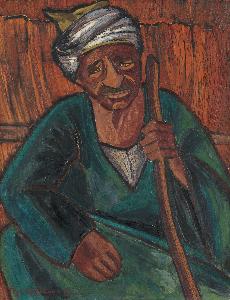Inji Efflatoun
Inji Aflatoun;Inji Efflatoun
Place: Cairo
Born: 1924
Death: 1989
Biography:
Inji Efflatoun, born on April 16, 1924, was a renowned Egyptian painter and activist in the women's movement. She was a leading spokeswoman for the Marxist-progressive-nationalist-feminist movement in the late 1940s and 1950s, as well as a pioneer of modern Egyptian art and one of the important Egyptian visual artists.
Early Life and Education
Inji Efflatoun was born in Cairo into a traditional Muslim family. She discovered Marxism at the Lycée Français du Caire and joined Iskra, a Communist youth party. After graduating from the Fuad I University in Cairo, she became a founding member of the Rabitat Fatayat at jami'a wa al ma' ahid (League of university and Institutes' Young Women) in 1945.
Artistic Career
Inji Efflatoun's artistic career was marked by her unique style, which was influenced by surrealist and cubist aesthetics. Her paintings are filled with lively brushstrokes of intense color, reminding some observers of Van Gogh or Bonnard. She stopped painting from 1946 to 1948, considering that what she was painting no longer corresponded to her feelings. However, her interest in art was later renewed after visiting Luxor, Nubia, and the Egyptian oases.
Notable Works
Some of Inji Efflatoun's notable works include Mathbahat Dinshaway, a painting that showcases her unique style and technique. Another notable work is The Worker, a powerful representation of the human struggle and resilience. These paintings are now housed at The Barjeel Art Foundation in Sharjah, United Arab Emirates.
Legacy
Inji Efflatoun's legacy extends beyond her artwork. She was a pioneer of modern Egyptian art and a leading spokeswoman for the Marxist-progressive-nationalist-feminist movement. Her contributions to the art world can be seen in her numerous exhibitions, including those at The Venice Biennale in 1952 and The São Paulo Art Biennial in 1956.
- Her artwork is characterized by an increasing use of large white spaces around her forms.
- She was able to continue painting during her imprisonment, with her early prison paintings being portraits and later ones being landscapes.
- Her art of later years is characterized by an increasing use of large white spaces around her forms.
Inji Efflatoun's life and work serve as a testament to her dedication to the arts and her commitment to social justice. Her legacy continues to inspire artists and activists alike, and her contributions to modern Egyptian art remain unparalleled. Important links: https://Wikioo.org/@/Inji-Efflatoun https://Wikioo.org/Art.nsf/O/A@D3CR6P https://Wikioo.org/@@/D797DU-Inji-Efflatoun-The-Worker-حمال-الطوب Note: The above article is based on the provided text and may not be a comprehensive biography of Inji Efflatoun.








